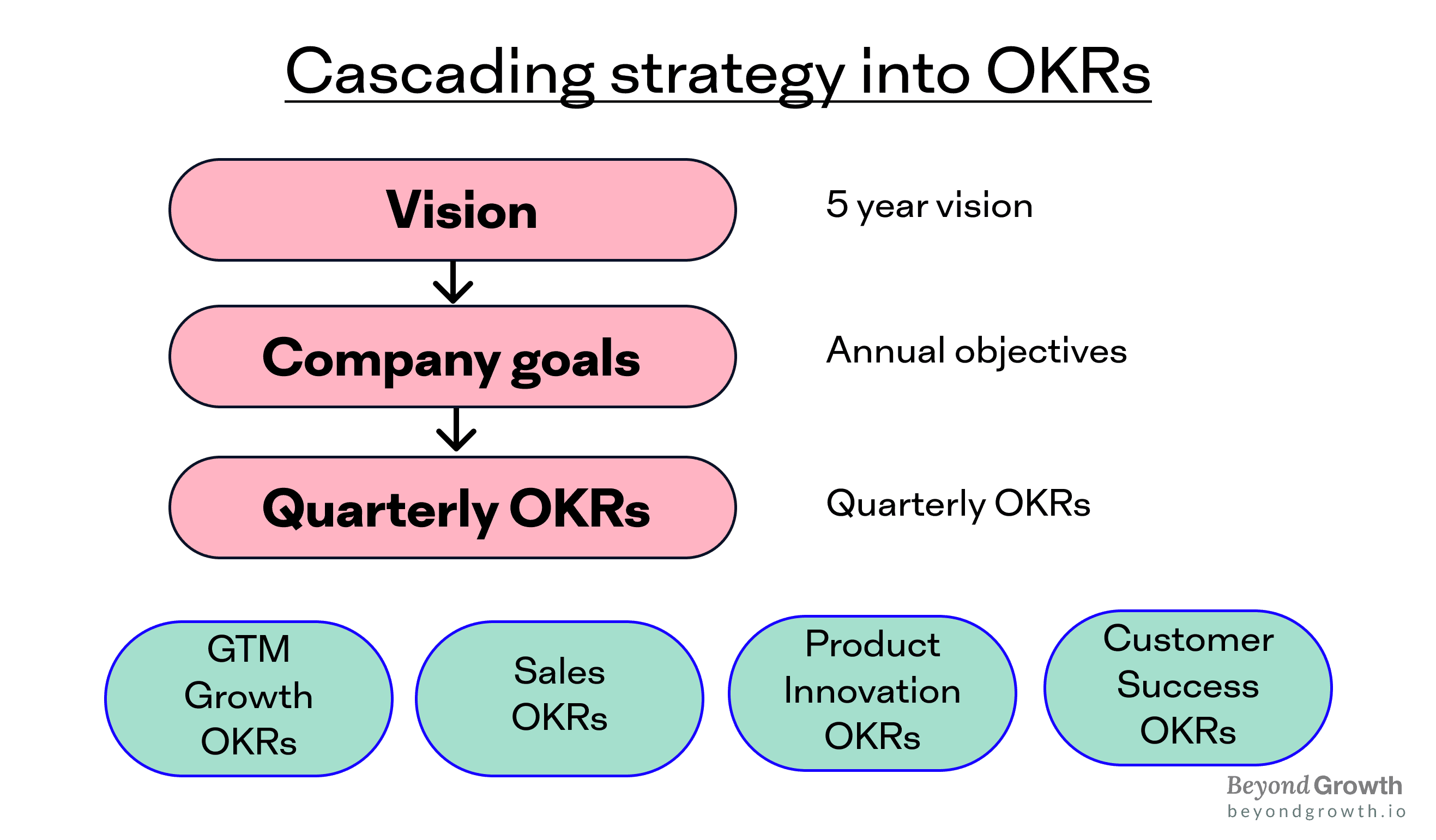Using OKRs to translate marketing strategy into effective execution.
Using OKRs to translate marketing strategy into effective execution.
Staying focused and aligned with OKRs during (marketing) strategy implementation.
Staying focused and aligned with OKRs during (marketing) strategy implementation.
Last edited on:
Sep 30, 2024
Author:
Jordy Oost



At Beyond Growth, we specialize in developing and executing marketing strategies and go-to-market plans. A crucial element in marketing is not just crafting strategies, but also effectively executing them and maintaining organizational alignment throughout the process.
To bridge the gap between strategy and execution, we often employ Objective Key Results (OKRs), a straightforward goal-setting methodology that aligns and focuses our entire organization. In this article, we'll guide you through everything you need to know to successfully implement OKRs in your organization.
At Beyond Growth, we specialize in developing and executing marketing strategies and go-to-market plans. A crucial element in marketing is not just crafting strategies, but also effectively executing them and maintaining organizational alignment throughout the process.
To bridge the gap between strategy and execution, we often employ Objective Key Results (OKRs), a straightforward goal-setting methodology that aligns and focuses our entire organization. In this article, we'll guide you through everything you need to know to successfully implement OKRs in your organization.
A short history of OKRs
OKRs were introduced in the 1970s as a goal setting framework at Intel by Andrew Grove. Grove was a pioneering tech executive and former CEO of Intel, known for his role in transforming the company into a dominant force in the semiconductor industry.
At a later point it was introduced and popularized by John Doer. He introduced the idea of OKRs to Google in the 1990s. This idea quickly became central to Google's culture. It served as a management methodology that helped ensure the company focused its efforts on the same important issues throughout the organization.
The OKR methodology proved at those companies to not only clarify objectives but also to align efforts across the organisation, ensuring that strategy translates effectively into actionable results.
That is the reason that today this goal-setting framework is used by companies such as Linkedin, Spotify, Netflix and Salesforce.
A short history of OKRs
OKRs were introduced in the 1970s as a goal setting framework at Intel by Andrew Grove. Grove was a pioneering tech executive and former CEO of Intel, known for his role in transforming the company into a dominant force in the semiconductor industry.
At a later point it was introduced and popularized by John Doer. He introduced the idea of OKRs to Google in the 1990s. This idea quickly became central to Google's culture. It served as a management methodology that helped ensure the company focused its efforts on the same important issues throughout the organization.
The OKR methodology proved at those companies to not only clarify objectives but also to align efforts across the organisation, ensuring that strategy translates effectively into actionable results.
That is the reason that today this goal-setting framework is used by companies such as Linkedin, Spotify, Netflix and Salesforce.
The place OKRs takes within our Go-to-Market and annual Marketing plans
When it comes to deploying a robust marketing strategy, particularly during the go-to-market (GTM) phase or within an annual marketing plan, the incorporation of Objectives and Key Results (OKRs) helps improve effectiveness and clarity.

The OKR method ensures that every marketing effort is directly tied to tangible outcomes, making it easier to track progress and make adjustments in real time. By setting OKRs on a quarterly basis you can focus on the most important elements of your strategy, while staying agile enough to adapt to learnings and changing market conditions.
Using OKRs helps in aligning the various teams—from product to sales and revops—ensuring that all departments are moving in harmony towards the same goals. This alignment is of special importance during a product launch, where coordinated effort across functions is necessary.
The place OKRs takes within our Go-to-Market and annual Marketing plans
When it comes to deploying a robust marketing strategy, particularly during the go-to-market (GTM) phase or within an annual marketing plan, the incorporation of Objectives and Key Results (OKRs) helps improve effectiveness and clarity.

The OKR method ensures that every marketing effort is directly tied to tangible outcomes, making it easier to track progress and make adjustments in real time. By setting OKRs on a quarterly basis you can focus on the most important elements of your strategy, while staying agile enough to adapt to learnings and changing market conditions.
Using OKRs helps in aligning the various teams—from product to sales and revops—ensuring that all departments are moving in harmony towards the same goals. This alignment is of special importance during a product launch, where coordinated effort across functions is necessary.
Can we help?
Are you in search of a Growth Marketer?
Fill in the form and get in touch
Want to learn about Growth Marketing?
Fill in the form and let's connect
Implementing OKRs
3.1 Start with alignment of teams and vision
(1) First, OKRs are a strategy execution tool. Thus, a strategy or at least a good sense of the direction you want to go in the long is vital before the creation of OKRs.
(2) Second, the OKR framework operates on two levels:
setting objectives, which are qualitative and inspirational goals, and
defining key results, which are quantitative outcomes that measure progress towards these goals.
(3) Third, the framework is cascading. The starting point is your company’s vision, from there you work downwards from yearly-, quarterly- to department goals.

This structure ensures that strategic planning is not just a top-down directive but a shared responsibility across levels.
Implementing OKRs
3.1 Start with alignment of teams and vision
(1) First, OKRs are a strategy execution tool. Thus, a strategy or at least a good sense of the direction you want to go in the long is vital before the creation of OKRs.
(2) Second, the OKR framework operates on two levels:
setting objectives, which are qualitative and inspirational goals, and
defining key results, which are quantitative outcomes that measure progress towards these goals.
(3) Third, the framework is cascading. The starting point is your company’s vision, from there you work downwards from yearly-, quarterly- to department goals.

This structure ensures that strategic planning is not just a top-down directive but a shared responsibility across levels.
3.2 Take the four OKR principles into account
The following principles are solid suggestions to take into account when creating OKRs:
Aim to achieve 70% of your OKRs (consistently reaching 100% suggests underperformance)
Avoid "binary" OKRs with metrics solely based on completion or non-completion.
OKRs should not cover all organisational activities. (Day-to-day campaign maintenance and on-call support are examples of work outside OKRs)
Finally, the best way to understand OKRs is through practice.
3.2 Take the four OKR principles into account
The following principles are solid suggestions to take into account when creating OKRs:
Aim to achieve 70% of your OKRs (consistently reaching 100% suggests underperformance)
Avoid "binary" OKRs with metrics solely based on completion or non-completion.
OKRs should not cover all organisational activities. (Day-to-day campaign maintenance and on-call support are examples of work outside OKRs)
Finally, the best way to understand OKRs is through practice.
4. Setting objectives and key results

4.1 Objectives
Objectives should stretch the organisation's capabilities but remain achievable. It all starts with a clearly defined strategy.
A common actionable 3-step approach looks like this:
Start with identification of your strategic year objectives.
Translate these objectives into yearly and quarterly company objectives and key results. Do take your sales and marketing resources and Go-to-Market plan into account during this stage.
Together with your teams and departments you set up team key results based on quarterly company objectives. This should be done per department during multiple alignment sessions with department stakeholders.
4.2 Key results
Key results should be quantifiable and time-bound, providing a clear metric for success.
“The key result has to be measurable. But at the end you can look, and without any arguments: Did I do that or did I not do it? Yes? No? Simple. No judgments in it.” - John Doer
4.3 Examples
(1) Sales team example
Objective
Personalize sales approach and nurture new potential customers better
Key results
KR1: Improve conversion % from “trial” to “paid” from 20% to 35%
KR2: Increase follow up email open rate from 14% to 45%
KR3: Reach 8/10 average score on customer satisfaction survey with at least 100 responses
(2) Customer success team example
Objective
Increase engagement with new customers
Key results
KR1: Triple communication open rate in-product from 6% to 18%
KR2: Increase follow-up meetings booked per week to 24
KR3: Reduce response time by 25%
4. Setting objectives and key results

4.1 Objectives
Objectives should stretch the organisation's capabilities but remain achievable. It all starts with a clearly defined strategy.
A common actionable 3-step approach looks like this:
Start with identification of your strategic year objectives.
Translate these objectives into yearly and quarterly company objectives and key results. Do take your sales and marketing resources and Go-to-Market plan into account during this stage.
Together with your teams and departments you set up team key results based on quarterly company objectives. This should be done per department during multiple alignment sessions with department stakeholders.
4.2 Key results
Key results should be quantifiable and time-bound, providing a clear metric for success.
“The key result has to be measurable. But at the end you can look, and without any arguments: Did I do that or did I not do it? Yes? No? Simple. No judgments in it.” - John Doer
4.3 Examples
(1) Sales team example
Objective
Personalize sales approach and nurture new potential customers better
Key results
KR1: Improve conversion % from “trial” to “paid” from 20% to 35%
KR2: Increase follow up email open rate from 14% to 45%
KR3: Reach 8/10 average score on customer satisfaction survey with at least 100 responses
(2) Customer success team example
Objective
Increase engagement with new customers
Key results
KR1: Triple communication open rate in-product from 6% to 18%
KR2: Increase follow-up meetings booked per week to 24
KR3: Reduce response time by 25%
In conclusion
The adoption of OKRs within organisations provides a structured approach to achieving strategic objectives but also enhances alignment across departments, optimizes resource allocation, and improves the ability to react in an agile way.
Can we help?
Are you in search of a Growth Marketer?
Fill in the form and get in touch
Want to learn about Growth Marketing?
Fill in the form and let's connect
Stay up to date
Subscribe to receive the newest articles
The Beyond Growth Blog publishes montly content about driving growth in early stage companies, entrepreneurship and accelerating efficiency in B2B marketing operations.

© 2023 Beyond Growth
© 2023 Beyond Growth



